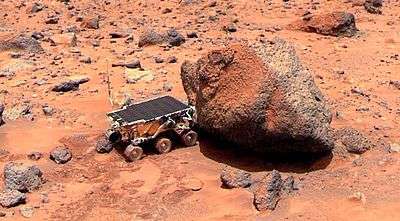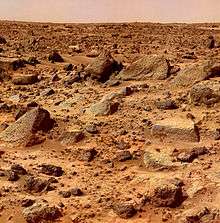Mars surface color

The Mars surface colour looks reddish from a distance because of rusty dust kicked up in the atmosphere.[1] From close up it is more of a butterscotch,[1] and other common surface colors include golden, brown, tan, and greenish, depending on minerals.[1][2]
The apparent colour of the Martian surface enabled humans to distinguish it from other planets early in human history and motivated them to weave fables of war in association with Mars. One of its earliest recorded names, Har decher, literally meant "Red One" in Egyptian.[3] Its color may have also contributed to a malignant association in Indian astrology, as it was given the names Angaraka and Lohitanga, both reflecting the distinctively red color of Mars as seen by the naked eye.[3] Modern robotic explorers have shown that not only the surfaces, but also the skies above may appear red under sunlit conditions on Mars.
Reason for red and its extensiveness
Modern observations indicate that Mars's redness is skin deep. The Martian surface looks reddish primarily because of a ubiquitous dust layer (particles are typically between 3 µm to 45 µm across [4][5]) that is typically on the order of millimeters thick. Even where the thickest deposits of this reddish dust occur, such as the Tharsis area, the dust layer is probably not more than 2 m (7 feet) thick.[6] Therefore, the reddish dust is essentially an extremely thin veneer on the Martian surface and does not represent the bulk of the Martian subsurface in any way.

Martian dust is reddish mostly due the spectral properties of nanophase ferric oxides (npOx) that tend to dominate in the visible spectrum. The specific npOx minerals have not been fully constrained, but nanocrystalline red hematite (α-Fe2O3) may be the volumetrically dominant one,[7] at least at the less than 100 µm sampling depth[8] of infrared remote sensors such as the Mars Express OMEGA instrument. The rest of the iron in the dust, perhaps as much as 50% of the mass, may be in titanium enriched magnetite (Fe3O4).[9] Magnetite is usually black in colour with a black streak,[10] and does not contribute to the reddish hue of dust.
The mass fraction of chlorine and sulfur in the dust is greater than that which has been found (by the Mars Exploration Rovers Spirit and Opportunity) in the soil types at Gusev crater and Meridiani Planum. The sulfur in the dust also shows a positive correlation with npOx.[11] This suggests that very limited chemical alteration by thin brine films (facilitated by the formation of frost from atmospheric H2O) may be producing some of the npOx.[11] In addition, remote sensing observations of atmospheric dust (which shows slight compositional and grain size differences from surface dust), indicates that the bulk volume of dust grains consists of plagioclase feldspar and zeolite, along with minor pyroxene and olivine components.[12] Such fine material can be generated easily via mechanical erosion from feldspar-rich basalts, such as rocks in the southern highlands on Mars.[12] Collectively, these observations indicate that any chemical alteration of dust by aqueous activity has been very minor.
The occurrence of npOx in dust
There are several processes that can yield npOx as an oxidation product without the involvement of free O2. One or more of those processes may have dominated on Mars, since atmospheric modeling over geologic time scales indicates that free O2 (generated mostly via the photodissociation of H2O)[13] may have always been a trace component with a partial pressure not exceeding 0.1 µPa.[14]

One O2-independent process involves a direct chemical reaction of Fe2+ (commonly present in typical igneous minerals) or metallic Fe with H2O to produce Fe3+(aq), which typically leads to hydroxides such as goethite (FeO•OH)[13] under experimental conditions.[15] While this reaction with H2O is thermodynamically disfavored, it may be sustained nevertheless, by the rapid loss of the H2 byproduct.[14] The reaction can be further facilitated by dissolved CO2 and SO2, which lower the pH of brine films increasing the concentration of the more oxidative H+.[15]
However, higher temperatures (c. 300 °C) are usually needed to decompose Fe3+ (oxy)hydroxides such as goethite into hematite. The formation of palagonitic tephra on the upper slopes of the Mauna Kea volcano may mirror such processes, as consistent with the intriguing spectral and magnetic similarities between palagonitic tephra and Martian dust.[16] In spite of the need for such kinetic conditions, prolonged arid and low pH conditions on Mars (such as diurnal brine films) may lead to the eventual transformation of goethite into hematite given the thermodynamic stability of the latter.[15]
Fe and Fe2+ may also be oxidized by the activity of hydrogen peroxide (H2O2). Even though the H2O2 abundance in the Martian atmosphere is very low,[14] it is temporally persistent and a much stronger oxidant than H2O. H2O2-driven oxidation to Fe3+ (usually as hydrated minerals), has been observed experimentally.[15] In addition, the pervasiveness of the α-Fe2O3 spectral signature, but not of hydrated Fe3+ minerals reinforces the possibility that npOx may form even without the thermodynamically disfavored intermediaries such as geothite.[7]
There is also evidence that hematite might form from magnetite in the course of erosion processes. Experiments at the Mars Simulation Laboratory of Aarhus University in Denmark show that when a mixture of magnetide powder, quartz sand, and quartz dust particles is tumbled in a flask, some of the magnetite converts to hematite, coloring the sample red. The proposed explanation for this effect is that when quartz is fructured by the grinding, certain chemical bonds get broken at the newly exposed surfaces; when these surfaces come in contact with magnetite, oxygen atoms may be transferred from quartz surface to magnetite, forming hematite.[17]
Red skies on Mars
Approximately true-colour in situ images from the Mars Pathfinder and Mars Exploration Rover missions indicate that the Martian sky may also appear reddish to humans. Absorption of sunlight in the 0.4-0.6 µm range by dust particles may be the primary reason for the redness of the sky.[18] An additional contribution may come from the dominance of photon scattering by dust particles at wavelengths in the order 3 µm,[5] which is in the near-infrared range, over Rayleigh scattering by gas molecules.[19]
References
- 1 2 3 NASA - Mars in a Minute: Is Mars Really Red? (Transcript)
- ↑ "What Is the real Color of Mars? - Check123, Video Encyclopedia". Check123 - Video Encyclopedia. Retrieved 2016-11-09.
- 1 2 Kieffer, Hugh H., Bruce M. Jakosky, and Conway W. Snyder (1992), "The planet Mars: From antiquity to the present," in Mars, University of Arizona Press, Tucson, AZ, p. 2 ISBN 0-8165-1257-4
- ↑ Fergason et al. (2006), doi 10.1029/2005JE002583
- 1 2 Lemmon et al. (2004), doi 10.1126/science.1104474
- ↑ Ruff and Christensen, 2002 doi 10.1029/2001JE001580
- 1 2 Bibring et al. (2006), doi 10.1126/science.1122659
- ↑ Poulet et al. (2007), doi 10.1029/2006JE002840
- ↑ Goetz et al. (2007)
- ↑ Mindat entry
- 1 2 Yen et al. (2005), doi 10.1038/nature03637
- 1 2 Hamilton et al. (2005) doi 10.1029/2005JE002501
- 1 2 Catling and Moore (2003), doi 10.1016/S0019-1035(03)00173-8
- 1 2 3 Chevrier et al. (2007), doi 10.1038/nature05961
- 1 2 3 4 Chevrier et al. (2006) doi 10.1016/j.gca.2006.06.1368
- ↑ Morris et al. (2001), doi 10.1029/2000JE001328
- ↑ Clara Moskowitz (September 2009). "How Mars Turned Red: Surprising New Theory". Yahoo News. Archived from the original on September 25, 2009. Retrieved 2009-09-21.
- ↑ Bell et al. (2006), doi 10.1029/2006JE002687
- ↑ Thomas et al. (1999), doi 10.1029/98JE02556
External links
- NASA - Mars in a Minute: Is Mars Really Red?
- ContactInContext - Mars, The "Golden Brown" (not Red) Planet?